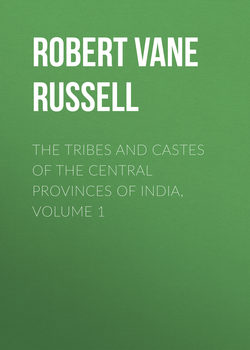Читать книгу The Tribes and Castes of the Central Provinces of India, Volume 1 - Robert Vane Russell - Страница 49
Part I.
Introductory Essay on Caste
Introductory Essay on Caste
46. Occupational subcastes
ОглавлениеMany subcastes are also formed from slight differences of occupation, which are not of sufficient importance to create new castes. Some instances of subcastes formed from growing special plants or crops have been given. Audhia Sunārs (goldsmiths) work in brass and bell-metal, which is less respectable than the sacred metal, gold. The Ekbeile Telis harness one bullock only to the oil-press and the Dobeile two bullocks. As it is thought sinful to use the sacred ox in this manner and to cover his eyes as the Telis do, it may be slightly more sinful to use two bullocks than one. The Udia Ghasias (grass-cutters) cure raw hides and do scavengers’ work, and are hence looked down upon by the others; the Dingkuchia Ghasias castrate cattle and horses, and the Dolboha carry dhoolies and palanquins. The Māngya Chamārs are beggars and rank below all other subcastes, from whom they will accept cooked food. Frequently, however, subcastes are formed from a slight distinction of occupation, which connotes no real difference in social status. The Hathgarhia Kumhārs (potters) are those who used to fashion the clay with their own hands, and the Chakarias those who turned it on a wheel. And though the practice of hand pottery is now abandoned, the divisions remain. The Shikāri or sportsmen Pardhis (hunters) are those who use firearms, though far from being sportsmen in our sense of the term; the Phanse Pardhis hunt with traps and snares; the Chitewale use a tame leopard to run down deer, and the Gayake stalk their prey behind a bullock. Among the subcastes of Dhīmars (fishermen and watermen) are the Singaria, who cultivate the singāra or water-nut in tanks, the Tānkiwālas or sharpeners of grindstones, the Jhīngars or prawn-catchers, the Bansias and Saraias or anglers (from bansi or sarai, a bamboo fishing-rod), the Kasdhonias who wash the sands of the sacred rivers to find the coins thrown or dropped into them by pious pilgrims, and the Sonjharas who wash the sands of auriferous streams for their particles of gold.89 The Gāriwān Dangris have adopted the comparatively novel occupation of driving carts (gāri) for a livelihood, and the Pānibhar are water-carriers, while the ordinary occupation of the Dāngris is to grow melons in river-beds. It is unnecessary to multiply instances; here, as in the case of territorial subcastes, the practice of subdivision appears to have been extended from motives of convenience, and the slight difference of occupation is adopted as a distinguishing badge.
89
Sonjhara is a separate caste as well as a subcaste of Dhīmar.
